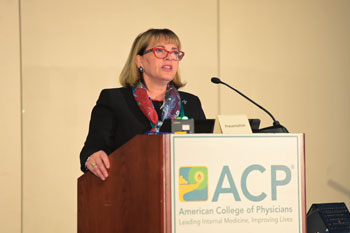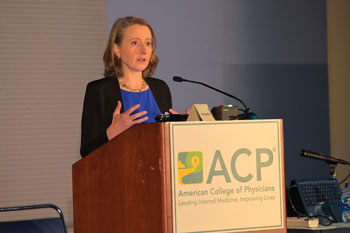
Don't miss these rare GI diseases
An expert offers evidence-based approaches to diagnosing and treating five rare disorders of the GI system at Internal Medicine Meeting 2022.
A patient living with a rare disease faces two distinct challenges, according to gastroenterologist Lucinda A. Harris, MD, MS, FACP.
“They not only have a rare disease that a lot of people either have blown off or not recognized, but they're also living where so few people understand what they're up against,” she said. “So I'd like you to keep that in mind and keep your mind open, when you're seeing patients who might present with symptoms suggestive of these disorders, that these things are real, and we should really be trying to identify them.”

During the “GI Syndromes You Don't Know Enough About” session at Internal Medicine Meeting 2022 in Chicago, Dr. Harris offered evidence-based approaches to diagnosing and treating five rare disorders of the GI system.
Non-celiac gluten sensitivity
Non-celiac gluten sensitivity involves signs and symptoms that develop after wheat ingestion in a patient without celiac disease, explained Dr. Harris, an associate professor of medicine at the Mayo Clinic Alix School of Medicine in Scottsdale, Ariz.
Gluten sensitivity is much more common than celiac disease or wheat allergy. While those two diseases have prevalences of about 1% and less than 3%, respectively, gluten sensitivity has an estimated prevalence of about 20%, she noted.
“I see patients with gluten sensitivity as well as celiac disease, and they don't have the immune response, but they certainly have a lot of the symptoms, including brain fog,” she said.
Proposed mechanisms of gluten sensitivity include a nocebo effect or a gluten-mediated response leading to altered permeability and immune activation/low-grade inflammation, Dr. Harris noted. In addition, gluten is a fructan, which can be a poorly absorbed carbohydrate that via fermentation can cause gas production, short-chain fatty acid formation, and microbiome changes that result in GI symptoms, she said.
Excluding celiac disease is still key. Many physicians were taught the classic presentation of celiac disease—diarrhea, steatorrhea, and weight loss or growth failure— but two-thirds of patients present in a nonclassical fashion, Dr. Harris said. “It is important to realize that two-thirds of patients present with nonclassical symptoms including osteoporosis, anemia, bloating, constipation, and non-GI symptoms,” she said. “Clinicians need to first suspect and rule out celiac disease.”
Patients need to be eating gluten for clinicians to diagnose celiac disease. The first step is serology, which consists of both a tissue transglutaminase-IgA level and an immunoglobulin A level (plus deaminated IgG antibodies in those with IgA deficiency), but the gold standard for diagnosing adults with celiac disease is an upper endoscopy with biopsy, said Dr. Harris.
She offered another reason to do the upper endoscopy. “Ten percent of patients who have negative serologies that have symptoms that are classic for celiac disease will have celiac disease on biopsy.”
A gluten-free diet is the current standard for treating both celiac disease and gluten sensitivity. “But realize that it's a challenging diet, that it is socially limiting. Think about coming to a big meeting like this and always having to read labels and worry if foods contain gluten,” Dr. Harris said.
If poorly absorbed carbohydrates are a potential culprit, a diet that restricts, then carefully reintroduces, fermentable oligosaccharides, disaccharides, monosaccharides, and polyols (FODMAPs) can help patients parse out the main offenders. But this diet is not for the faint of heart, Dr. Harris cautioned.
“When you ask someone to do a low-FODMAP diet, please don't ask them to do it by themselves, because it is a very confusing, challenging diet to do on one's own. … Use a dietitian who is well versed in both the gluten-free diet and the reintroduction phase of the low-FODMAP diet,” she recommended.
But treatment should not precede diagnosis, Dr. Harris emphasized. “When you do serology, please, please, please don't put a patient on a gluten-free diet until they've had biopsies, because that's the correct way still in the United States to diagnose celiac disease.”
If a patient believes they might have gluten sensitivity or celiac disease but is already eating a gluten-free diet, genetic tests for celiac disease may be helpful, “because if you don't have the genes, then it's almost impossible to have the disease,” she noted.
While about 30% of the population has the HLA-DQ2 and HLA-DQ8 genes, only about 1% actually get the disease, Dr. Harris said. So, although a genetic test is not sufficient for diagnosis, a positive result can guide clinicians toward suggesting a gluten challenge for patients who may have celiac disease. “I know it's very hard to go backwards from a gluten-free diet when people feel that it's helpful, so a genetic test can help one make the decision to do a gluten challenge,” she said.
Eosinophilic esophagitis
Classic symptoms of eosinophilic esophagitis include dysphagia, food impaction, heartburn, and chest pain, but these are not the only ones to watch for, Dr. Harris noted. “Don't think that someone doesn't have this disorder if their only presenting symptoms are nausea and vomiting,” she said.
Esophagogastroduodenoscopy with esophageal biopsy remains the necessary diagnostic test. Biopsies need to be done of the proximal, mid, and lower third of the esophagus. Patients with eosinophilic esophagitis have eosinophil-predominant inflammation, with 15 or more eosinophils per high-power field, Dr. Harris said.
But internists should make sure to rule out secondary causes of increased eosinophils, including gastroesophageal reflux disease. “There is increased incidence of eosinophilic esophagitis, both in celiac disease and in a very rare disorder called eosinophilic gastroenteritis, which also can be seen, and that's why you want to also just make sure that the eosinophilia is limited to the esophagus,” Dr. Harris said.
A double-contrast barium swallow X-ray can suggest or confirm the diagnosis but is likely underutilized, she added. “What you can determine from this is if there's a stricture due to the eosinophilic esophagitis or if there's narrowing,” Dr. Harris said. “It's a noninvasive test, it's cost-effective, and it's readily available, so those are the reasons to include that in the diagnostic workup of patients with eosinophilic esophagitis.”
As for treatment, the usual first-line therapy is a proton-pump inhibitor (PPI). “Then you go back and repeat endoscopic biopsies to see if the PPI therapy has been effective in reducing the eosinophilia,” she said. “If they have, PPI therapy can be used to maintain remission.”
Dr. Harris added that she believes the risks of PPIs have been “grossly overstated” in the popular media. “When you evaluate the quality of the studies done that purport a negative effect of PPIs, most of these studies have serious methodological flaws,” she said.
Diet and steroids are the two other main ways to treat patients with eosinophilic esophagitis, Dr. Harris said. “Occasionally, you have patients who would really like to do things ‘naturally,’ and for them an elimination diet can be very helpful for inducing remission.”
Dietary treatment options include an elemental diet and an allergy testing-directed diet, as well as an empiric elimination diet, which can be very challenging. “Basically, if you eliminate wheat and cow's milk, you'll cover over 80% of the foods that stimulate eosinophilic esophagitis. Others are eggs, soy, nuts, and fish,” said Dr. Harris, adding that a dietitian can set patients up for success.
The third and most difficult treatment to implement is swallowed topical steroids. “Steroids, even topical steroids, do have some long-term [risks], and there's also not commercially available product,” she said.
Patient preference should guide therapeutic decisions. While internists can work with patients to choose a single therapy, they need the help of a gastroenterologist in treating this disorder, as it's important to monitor response to treatment, Dr. Harris noted.
“I feel that a high-dose PPI is a very good first line of therapy, and dietary therapy can be first line, but you need to have a really motivated patient to do it,” she said. Since her talk, Dr. Harris noted that the FDA has approved its first pharmacological therapy for eosinophilic esophagitis, dupilumab, a monoclonal antibody.
Postural orthostatic tachycardia syndrome
More clinicians are getting better at recognizing postural orthostatic tachycardia syndrome (POTS), Dr. Harris said. The syndrome's cardinal hemodynamic feature is an excessive heart rate increase without a corresponding decrease in blood pressure, she said.
It is the most common cause of chronic orthostatic intolerance, has a female prevalence of about 4.5:1, and primarily affects young women ages 18 to 50 years, Dr. Harris noted. “This is classically the age group that we see also has irritable bowel syndrome.”
Similarly to irritable bowel syndrome (IBS), POTS can cause GI symptoms like abdominal bloating, diarrhea, and constipation, but dysphasia is also another GI symptom seen in POTS, she said. In addition, somatization, depression, and anxiety have all been observed in patients with POTS, which is also similar to IBS.
Further, GI symptoms in patients with POTS may be reflective of autonomic dysfunction causing a motility disorder, Dr. Harris said. “It's interesting because when you think motility disorder, you'd think that they might be more inclined to have slowed gastric emptying, but they actually seem to have more rapid gastric emptying.”
POTS can also occur with several other comorbidities, such as Sjögren's syndrome, Ehlers-Danlos syndrome, and mast cell activation syndrome (more on the latter two later), said Dr. Harris, who coauthored a review of POTS published in October 2018 by the American Journal of Gastroenterology.
She said she first got interested in POTS because she was seeing more and more of these patients coming into her practice billed as IBS. “I thought to myself, ‘There must be something else going on here,’” she said. “Initially I did not realize that there was an autonomic neurologist in our practice at Mayo, Dr. [Brent] Goodman, and patients were using the back door by telling me their GI complaints to get in to see him. So I did confirm a lot of diagnoses of POTS through my GI practice.”
The diagnosis of POTS usually requires referral to a neurologist or cardiologist who is particularly interested in this disorder, and the initial evaluation includes an autonomic reflex screen, Dr. Harris said. This test involves checking blood pressure and pulse in the supine and prone positions. Diagnostic criteria for adults also include a heart rate increase greater than 30 beats per minute within 10 minutes of upright posture, as well as absence of orthostatic hypotension within a minute of upright posture. Symptoms should be present for at least six months, and other conditions (e.g., dehydration, medications, other medical conditions, dietary influences) should be eliminated.
When considering POTS, Dr. Harris recommended some considerations for evaluation in addition to the usual medical history and physical examination. “Orthostatic vital signs might be something different than you normally do but might suggest this diagnosis,” she said. “EKG should be considered to eliminate cardiac disease or conduction defects.”
Key treatments for POTS are lifestyle changes: sufficient amounts of fluids, salt, and exercise. Dr. Harris said she recommends volume repletion of at least 2 L a day with salty fluid, such as a non-low-sodium version of chicken or vegetable broth.
As for treating symptoms, nausea is the most challenging, she said. “I don't hesitate to use complementary medicine treatments such as ginger, ginger tea, fennel, aromatherapy—those can all be helpful,” Dr. Harris said. “For treating chronic abdominal pain, it's much like treating patients with irritable bowel syndrome … [and] there's a whole range of medicines out there for constipation and even for diarrhea.”
Ehlers-Danlos syndrome
Ehlers-Danlos syndrome (EDS) has a population prevalence of 0.02%. This is a noninflammatory, inheritable connective tissue disorder characterized by hyperflexible joints, hyperelastic skin, and tissue fragility.
EDS affects mostly young to middle-aged women and is more common in patients with POTS, Dr. Harris noted. One study of more than 600 patients with EDS or other hypermobility spectrum disorders, published in August 2020 by Neurogastroenterology & Motility, found that 37.5% had received a diagnosis of POTS. In addition, 98% of participants had a functional GI disorder.
EDS, particularly the hypermobile subtype, is present in about 18% of patients with POTS, Dr. Harris noted. While there are several clinical subtypes, vascular EDS is the only one where genetic counseling can be helpful, she added.
“The type of Ehlers-Danlos that you really want to rule out is the vascular EDS, and this is associated with a defect in type III collagen, and rarely type I,” she said. “But with hypermobile Ehlers-Danlos syndrome, we have not isolated the gene yet.”
To assess for hypermobility, clinicians can use the Beighton scale, which tests a patient's mobility in the left and right fingers, thumbs, elbows, and knees, as well as the spine. “This is kind of fun to do in practice,” said Dr. Harris, demonstrating one test by bending back her pinky finger. A positive score is 5 out of a possible 9 points for an adult (4 out of 9 for those over age 50 years and 6 out of 9 for children).
Patients with EDS have a higher prevalence of motility disorders, including constipation, dysphagia, gastroparesis, and pelvic floor dysfunction, she noted. Treatment includes GI symptom-guided therapy, as well as physical therapy for pelvic floor dysfunction. “Getting them into physical therapy and counseling them about movement and moving correctly can be very helpful in preventing further complications of the EDS on joints,” Dr. Harris said.
Mast cell activation syndrome
Mast cell activation syndrome completes a clinical triad with POTS and hypermobile EDS, she said. There is also an association between mast cell activation, non-celiac gluten sensitivity, and disorders of gut-brain interaction, Dr. Harris noted.
Mast cells in the GI tract regulate GI function and communicate with the enteric nervous system. “They are thought to be implicated in having a role in a lot of GI disorders, such as celiac disease and [inflammatory bowel disease],” she said.
When you see flushed skin, think mast cell activation. “Very classically, you often see patients coming in and they're very flushed,” Dr. Harris said. “This can be a sign of mast cell activation, particularly in their neck and women in their chest area.”
Other signs and symptoms of mast cell activation syndrome include abdominal pain, dermatographia, headache, neuropsychiatric symptoms, and diarrhea. Classic triggers include alcohol, stress, heat, strong smells, and certain medications and foods.
Proposed criteria to diagnose the syndrome were published in February 2019 by the Journal of Allergy and Clinical Immunology. These criteria include symptoms in at least two organ systems, objective evidence of mast cell release or chronically elevated mast cells (with tryptase being the preferred marker), and response to therapy that blocks mast cell mediator activity (e.g., antihistamines, mast cell stabilizers, leukotriene receptor antagonists).
The key for internists is to suspect the disorder, but it's also important to rule out systemic mastocytosis, hematologic leukemia, and other differential diagnoses for patients with elevated tryptase levels before assuming mast cell activation, Dr. Harris advised.
But even if a clinician ordered all the possible tests, levels of the markers are not always elevated in patients with this syndrome, she cautioned. “So, in order to really diagnose this disorder, you do need the help of an allergist.”
However, if a patient appears to have mild mast cell symptoms and classic triggers, “I think it's reasonable to consider treatments with H2 blockers, H1 blockers, and cromolyn as an initial trial of treatment,” Dr. Harris said.




